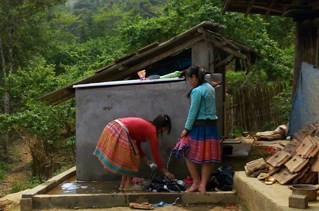(VOVworld) – The National Assembly Standing Committee is scheduled to examine a supervisory report on the implementation of poverty reduction policies from 2005-2012 early next month. The report reviews poverty reduction results and puts forward recommendations for working towards sustainable outcomes. The report will be submitted to the National Assembly at its 7th session.
 |
Part of the poverty reduction program in ethnic minority groups was building water supply system
|
From 2005 to 2012, poverty reduction was a primary task in Vietnam, which involved the whole society.
Overall poverty reduction
During the review period, the National Assembly issued 10 resolutions and 20 laws with direct and indirect relevance to poverty reduction.
The government reserved resources for poverty reduction and social security. The percentage of poor households fell an average of 2% annually. Do Manh Hung, Vice Chairman of the National Assembly’s Committee for Social Affairs and Deputy Head of the National Assembly’s delegation overseeing poverty reduction, said: “Our supervisory results show that poverty reduction has received social support and resources. The poverty rate decreased dramatically. The rate fell from 14.2% in 2010 to 7.8% in 2013. These encouraging results were acknowledged by the UN and many countries.”
Vietnam’s poverty reduction results are unstable. Many households remain near the poverty line and are in danger of falling back into poverty. Poverty exists mainly among ethnic minority groups, in areas prone to natural disasters, and in mining areas. Vietnam’s policies on poverty reduction are inconsistent and overlapping and plagued by insufficient allocation of resources. 90% of the investment in poverty reduction comes from the state budget. Bui Sy Loi, Vice Chairman of the National Assembly’s Committee for Social Affairs, said: “We have identified two basic poverty groups. First, for ethnic minority groups in isolated mountain regions, the rate of poor households is 47% and extremely poor of 68%. Second are poor people living in industrial and processing zones. The government and functional agencies must adjust that policies to obtain sustainable results in poverty reduction.”
Major orientations for the future
Do Manh Hung says the National Assembly should shift to a multi-dimensional poverty reduction approach covering income and people’s access to social services. “Our recommendations are to increase resources for poverty reduction and create a medium term plan for investment allocation. Local administrations must heighten their sense of responsibility and decentralize authority to encourage local innovation. Policies should promote consensus by allowing the people to participate in creating poverty reduction policies.”
Poverty reduction is a prominent of the Vietnamese Party and State. Applying practical measures will ensure sustainable poverty reduction outcomes.